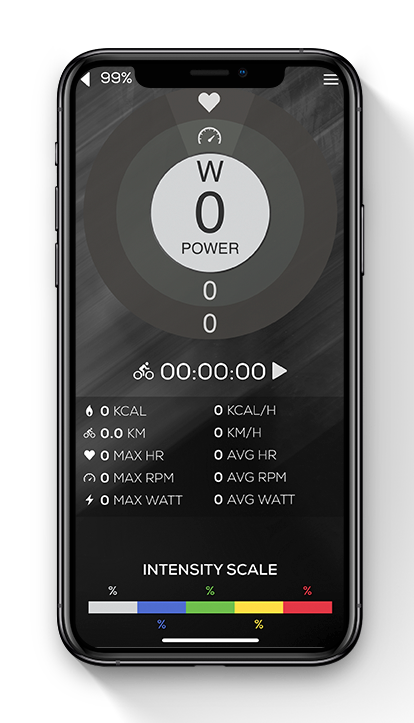Watching professional cyclists pedal with ease is almost hypnotic as their legs seem to move effortlessly to pedal the bike – not to mention they’re gliding along at the speed of a car (average professional cyclists ride between 40 – 45 km/h).
Essentially speaking, the rhythm they’re exhibiting is their cadence.
Cadence is the rate at which a cyclist pedals.
It’s the number of revolutions per minute (RPM) and is directly related to the wheel speed.
Is there a best speed?
Not technically speaking, but there are some guidelines to help keep you focused during your workout.
For the average indoor cyclist, with a good fitness level, a cadence of about 80-90 RPM is logical to aim for.
Just as cadence can vary between riders, it can also vary between situations.
For example, a steep uphill climb will affect your cadence because it's likely that you’ll have to slow down and increase the resistance in order to climb the incline effectively.
Whereas a sprint session will have your cadence increasing because of the attempt to cycle as fast as you can for the period of time.
Riding at a higher cadence and a lower resistance will put more pressure on your cardiovascular system.
While riding at a lower cadence and higher resistance will increase your muscle development and strength.
The two different areas that indoor cycling impacts are of equal importance because in developing your lung and heart capacity, you're increasing your opportunities to build strength by pushing your body harder. This can only be achieved when the cardiovascular strength is there to hold the body at the peak level.
This is why all indoor cycling training programs contain a mixture of high cadence/low resistance and low cadence/high resistance portions – to keep your body working and strengthening both areas.
The trick is to never complete the same workout twice and always keeping your body exposed to something new in order to challenge and increase strength.
Can you improve your cadence?
You can definitely improve your cadence – but here, the aim is to improve the quality of your cadence for your personal goals, not just aim to get faster.
To improve your cadence the first step is to measure what it currently is.
The best way to do this is using your BODY BIKE App.
When paired with your BODY BIKE SMART+, this app will allow you to accurately track your cadence during a variety of rides and workout styles.
Once you’ve determined what your current cadence is, you can make subtle changes over time to improve it in line with your cycling goals.
We recommend training at least 3 times a week as you’ll be able to create a consistent change over time - cyclists who only ride on weekends often have trouble maintaining the cadence switch because they are not practicing enough.
To effectively change your cadence, determine what you want to aim for (say you’re at 70 RPM and you want to move to a consistent 80-90 RPM) then you will want to consciously track your cadence during your rides.
Keep an eye on your BODY BIKE App during your workout and ensure you keep a steady cadence.
Because this is a new speed and rhythm for your legs to get used to, you’ll find yourself slipping back into a comfortable speed if you are not watching the cadence consistently.
Training programs
Our Brand Ambassador, Kim Gibas, created two short workouts to help you work on improving your cadence.
Session 1 is single leg training to help improve fluidity. This means that your pedalling is smooth and you can maintain a cadence of 90 RPM while cycling.
Having a great pedal style allows your body to work more efficiently and save energy.
Session 1: Isolated Leg Training
Warm-up:
- 5 minutes - easy pedalling with a cadence above 90 RPM
- 6 minutes - alternating 80% workload: 1 minute on right leg, 1 minute on left leg
Working Set:
Complete 7 reps
- 3 minutes - alternate 1 minute right leg, 1 minute both legs, 1 minute left leg. Maintain 85-90 RPM.
** prop resting leg on a chair set up on either side of the bike**
Cool Down:
- 5 minutes - easy pedalling
Session 2 works to improve your cycling economy. This has a similar end goal as the first workout - to improve your cycling efficiency.
This workout trains your body to switch between different cadences which increases your ability to generate power in each pedal stroke.
Session 2: High-Cadence Economy Training
Warm-up:
- 5 minutes - easy pedalling in a light gear, with a cadence above 90 RPM
- 6 minutes - alternating 80% workload: 1 minute on right leg, 1 minute on left leg
Working Set:
Complete 4 reps
- 3 minutes with a cadence of 100 RPM
- 2 minutes with a cadence of 80 RPM
- 1 minute with a cadence of 110-120 RPM
- 5 minutes recovery in a light gear with a cadence of 85-90 RPM
Cool Down:
- 5 minutes easy pedalling
Start small
It’s about making small incremental changes as this will allow your body to create new muscle memory, rather than shocking it into something too difficult too quickly.
Increasing your cadence is great for improving your overall fitness levels – remember that increasing your cadence is for a better performance if you want it, don’t increase your speed just for the sake of increasing it.
You’ll also find that the more experience you get, the more you’ll be able to vary your cadence to suit the type of ride you’re on.
